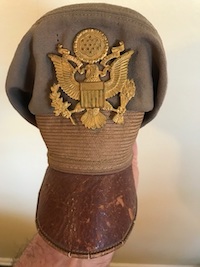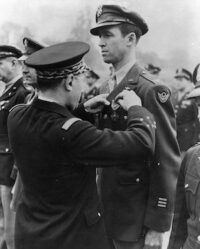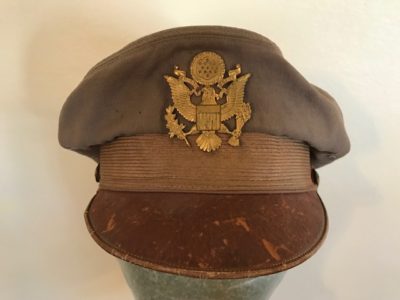With some 15 million Americans in service during WW II, wearing a military uniform became the fashion plate for an entire generation. It seemed you needed a scorecard to tell them apart. In addition to each service having their own distinctive uniform, there were subsets of uniforms, depending on the job, climate, or occasion in which the uniform was being worn. General George Patton even designed a uniform for his tankers, which featured gold buttons and a gold tanker’s helmet. It was rejected by the War Department.
 Often necessity led to a modification or in some cases an entirely new design. A perfect example was the development of camouflage uniforms mirroring the jungle environment of the South Pacific. There was one modification to a piece of uniform headgear, born out of necessity and made by the troops themselves, that has become the iconic symbol of the Army Air Force Combat Pilot. It became known as the “50 Mission Crush” or simply “The Crusher.”
Often necessity led to a modification or in some cases an entirely new design. A perfect example was the development of camouflage uniforms mirroring the jungle environment of the South Pacific. There was one modification to a piece of uniform headgear, born out of necessity and made by the troops themselves, that has become the iconic symbol of the Army Air Force Combat Pilot. It became known as the “50 Mission Crush” or simply “The Crusher.”
 Bomber pilots often wore their officer service caps in the cockpits of their planes. These caps had a stiff leather visor and a wire stiffener that ran around the crown of the hat to maintain its round, military appearance. This made it difficult to wear radio headphones over the service cap. In the interest of practicality and comfort, pilots began removing the stiffeners, thereby making it easier to wear the hat with radio headphones. It also gave the hat a “crushed” appearance. The more missions one flew, the more crushed it became, leading it to become the badge of an experienced, combat pilot. In the inset photo actor Jimmy Stewart, a real combat pilot in WW II, is wearing a “Crusher” while being decorated by an officer wearing the traditional rigid-crowned hat.
Bomber pilots often wore their officer service caps in the cockpits of their planes. These caps had a stiff leather visor and a wire stiffener that ran around the crown of the hat to maintain its round, military appearance. This made it difficult to wear radio headphones over the service cap. In the interest of practicality and comfort, pilots began removing the stiffeners, thereby making it easier to wear the hat with radio headphones. It also gave the hat a “crushed” appearance. The more missions one flew, the more crushed it became, leading it to become the badge of an experienced, combat pilot. In the inset photo actor Jimmy Stewart, a real combat pilot in WW II, is wearing a “Crusher” while being decorated by an officer wearing the traditional rigid-crowned hat.
While not adopted by the other services and initially frowned upon by the Army Air Force, it proved an immensely popular look with Army Air Force pilots and non-pilots alike. True “Crushers” were even made and privately purchased. They were not fitted with the wire stiffener and had a completely flexible visor. The hat could then be folded and put in one’s back pocket when not being worn. Technology in the form of planes flying at higher altitudes and the development of fire-retardant materials put an end to “The Crusher.” Today, it remains the quintessential symbol of the WW II Army Air Force combat pilot.



0 comments on “When Air Force pilots were “crushing it””